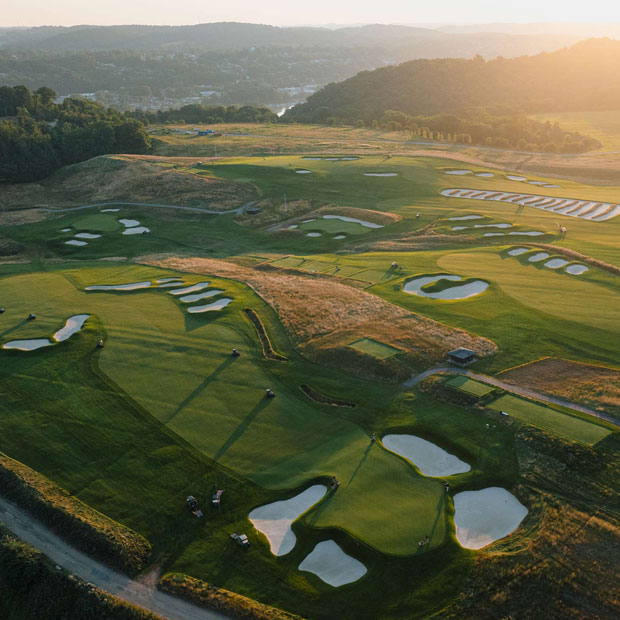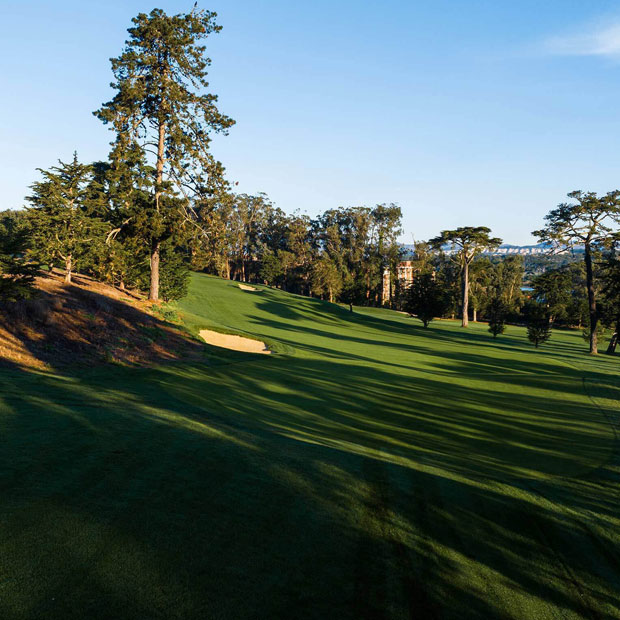Golf Course Architecture 101, Part 4: Greens
An introduction to the design of greens and surrounds at golf courses


It’s tough to think of a great golf hole that doesn’t have a great green.
In most rounds, roughly half of a player’s shots occur on and around the greens, so a golf architect needs to put a great deal of effort into getting the greens and surrounds exactly right: making them challenging but not impossible, interesting but not absurd. The best greens are distinctive and memorable, and exert an influence on strategy all the way back to the tee. They also give the golfer a multitude of options for playing shots into and around them. (I’ll explain what I mean by all of that below.)
There are many different types of greens, but this post focuses on the overarching philosophy of green design, and why a great green tends to be a prerequisite for a great hole.
Strategy
Putting greens to a golf course are what the face is to a portrait. –C.B. Macdonald
A green and its surrounds can have a major influence on a player’s overall tactical approach to a hole. On many well-crafted greens, different pin positions demand different strategies.
Consider the 5th green at Chicago Golf Club, a Seth Raynor design. Its main features are a false front and a pronounced knob in the middle. Since Chicago Golf has fiery playing conditions, these contours have a real impact. You have to think about them from the beginning to the end of the hole.
The 5th is a short par 4, and you can hit almost whatever club you want from the tee. The first order of business is hitting the fairway because the firm, undulating green is unkind to low-spin approaches from the rough. The secondary considerations are which side of the fairway to favor and how far up to push. Everything depends on the location of the hole relative to the central knob. If the pin is left of it, it’s tough to come in from the right. If the pin is right of the knob, the false front makes shorter pitches tricky. If the pin is behind the knob, players with longer approaches will need to avoiding landing their ball on the downslope of the knob and shooting off the back of the green.
Chicago Golf Club may have the best collection of greens in the country, and one reason why is that they all have a strategic impact.

Naturalness
Many of the world’s best greens are on the coasts of Great Britain and Ireland, where wind and sand created naturally undulating, freely draining putting surfaces. But in the past century, most courses have not been built on land this suitable. So a major part of a modern golf architect’s job is selecting green sites that drain well and then creating artificial contours that blend seamlessly into their natural settings. There is a lot of art to making an intensively designed green appear as though it has always been there.
Variety
Eighteen flat greens are to me an abomination, and the pleasantly undulating green which provides “possible” putting even in a dry summer is far preferable. –Harry Colt
Part 2 of our Golf Course Architecture 101 series covered this topic thoroughly, but the basic idea bears repeating: variety is the spice of life as well as golf course design. At the best courses, each green has its own distinct identity. Conversely, the least inspiring courses tend to be the ones where the greens all seem to be the same. So by varying the size, shape, contouring, and hazarding of each green, an architect can keep players on their toes and make the round more surprising and fun.
Here are some examples of the many types of green designs that architects have at their disposal:
{{content-block-golf-course-architecture-101-part-4-greens-surrounds-001}}
Size and receptiveness
Greens should be suited to the type of approach shot most commonly played into them.
For example, say a hole asks most players to hit a long iron or hybrid on their approach after a well-struck drive. The green should have enough room and forgiveness for a low-trajectory, low-spinning shot to stay on the putting surface. If the green is small or severe, there should be room to for players to land their approaches short and run them up.

On a shorter hole, where players typically approach the green with short irons or wedges, the architect has more freedom. Greens of any size can work. The contours can be bold, and the surrounds punishing.

Of course, these are just guidelines to green-building. There are no rules. I can think of a number of great holes that call for hefty approaches into severe greens. For example, the Redan holes at Shinnecock Hills and National Golf Links of America are plenty long, yet their putting surfaces are heavily sloped.
If Shinnecock and National had been built in the 20th century, these greens may not have made it to opening day. Because of a heightened sensitivity to criticism in the golf world, today’s architects have to be more cautious. And that’s not a good thing for the art of golf course design. Architects should have the freedom to be daring and unconventional when they see fit.
Pinnable surface
Not every section of every green can accommodate a hole location—nor should it. But a massively sloped green that has only two or three different places for a pin will get boring after a few rounds. On the other hand, a green with an array of subtler nooks and crannies will give the grounds crew a chance to change things up on a daily basis.
There are a couple of common reasons that courses lose pin positions. First, as green speeds have increased with advances in agronomy, slopes that were intended by the architect to be pinnable often become unpinnable. Second, greens tend to shrink over time because of limited maintenance budgets and sloppy mowing patterns. One easy way for an older course to improve is to recapture lost pinnable surface, allowing for more interesting hole locations and more day-to-day variety.
Surrounds and the ground game
The hazards around a green are just as important as the contours on it. And when I say “hazards,” I don’t mean just bunkers, creeks, and ponds, which can become crutches for designers trying to make their greens challenging. Closely mown slopes, humps, and hollows can also make terrific green-side features. Not only do they tend to be more natural and cheaper to build and maintain, but they also open possibilities for creative, ground-based recovery shots. A tricky run-off area with fairway-height grass can be negotiated in many different ways, stimulating thought for better players and offering forgiveness to less skilled golfers.

For Part 5 of Golf Course Architecture 101 (on construction methods, soils, and drainage), CLICK HERE.
Leave a comment or start a discussion
Engage in our content with thousands of other Fried Egg Golf Club Members
Engage in our content with thousands of other Fried Egg Golf Members
Get full access to exclusive benefits from Fried Egg Golf
- Member-only content
- Community discussions forums
- Member-only experiences and early access to events














Leave a comment or start a discussion
Lorem ipsum dolor sit amet, consectetur adipiscing elit. Suspendisse varius enim in eros elementum tristique. Duis cursus, mi quis viverra ornare, eros dolor interdum nulla, ut commodo diam libero vitae erat. Aenean faucibus nibh et justo cursus id rutrum lorem imperdiet. Nunc ut sem vitae risus tristique posuere. uis cursus, mi quis viverra ornare, eros dolor interdum nulla, ut commodo diam libero vitae erat. Aenean faucibus nibh et justo cursus id rutrum lorem imperdiet. Nunc ut sem vitae risus tristique posuere.